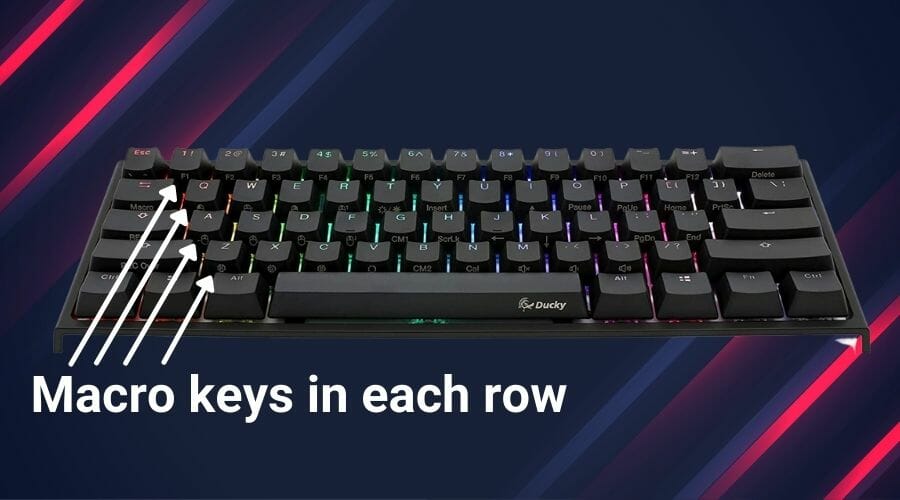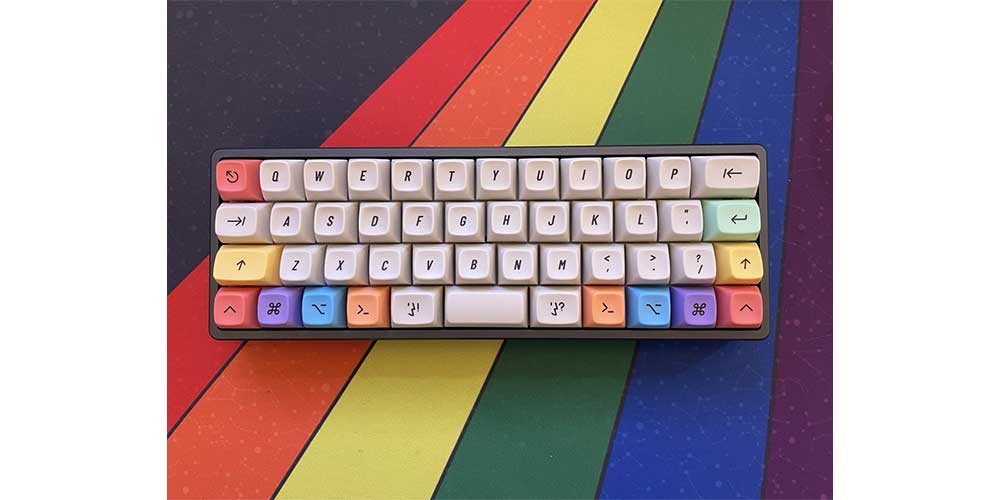So you've decided to dive deep into the rabbit hole of mechanical keyboards, but don't know which keyboard sizes are best?
No need to worry.
We've tested a ton of different keyboards, from full-sized all the way down to 60% (sorry 40% users, I just can't live without my numbers).
In this article, you will learn what the difference between each keyboard size is, and how to determine which one is the right one for you.
Let's dive in!
The best keyboard size comes down to personal preference and is highly dependant on your needs.
Here's a quick list we've rounded up based on each average keyboard use:
Before we start, here's a quick list of keyboard terminology to get yourself familiar with:

If you are in a career that uses many numbers or inputs a lot of data, full-sized keyboards are the way to go.
Naturally, if you type many numbers daily, you use the Numpad very often, as it's faster than the standard number row on top of alphanumeric (typing) keys.
If you've used a computer, chances are you've started with a full-sized keyboard, which is the most common keyboard used in office spaces.
For gamers, full-sized keyboards are too bulky, as the Numpad takes a lot of space.
The exception to this is if you play games that utilize many keys, which means having those extra buttons for key binds or macros would be beneficial.
Additionally, you can snatch a TKL keyboard and buy an external Numpad to place on your left-hand side.
That way, you can use the arrow keys for quick navigation, assuming that you are working in spreadsheets.
1800 Compact (96%) Keyboards include all the keys a standard full-sized keyboard would have, the difference being that all keys are bunched together.
Not all 1800 Compact keyboards have a complete set of keys, so it's essential to double-check that you have all the keys you need before buying.
96% keyboards are rare nowadays, but they serve as the perfect middle-ground for those who find the lack of Numpad inconvenient but don't want the bulkiness of a full-sized keyboard.
This is a great hybrid keyboard for those who game and work on the same setup, using the same keyboard.
TKL keyboards are the best for most people as they completely rid the Numpad, save a ton of desk space, and make it easier to travel with because of their smaller form factor.
Because of the lack of Numpad, you can place your mouse closer to your keyboard, which is more comfortable and gives more freedom to move and flick around your mouse.
TKL keyboards are widely available, as they have risen in popularity over the years.
These prices also come at an affordable cost, especially if you want to get into the mechanical keyboard market.
TKL keyboards are the preferred keyboard size for most FPS players, in games like CS:GO and VALORANT.
If you like the TKL design, but want an even more compact build, then the 75% keyboard is an excellent choice.
75% keyboards are TKL builds but with all the keys bunched together, allowing for a more compact build and less typing travel time.
75% of keyboards typically place the Navigation keys close together, and align the Home, End, Pg Up, and Pg Down keys vertically so save on width.
There's not much difference between a TKL and a 75% keyboard in terms of useability, so it comes down to personal preference.
You will need to spend some extra time looking for custom keycaps if you plan to upgrade 75% keyboards, as their keys may come in different sizes.
I find 75% keyboards more visually appealing in comparison to TKL keyboards.
If you never use your Function row and your Numpad but still want your Navigation keys, then the 65% keyboard is convenient.
The 65% build will suit minimalists and gamers who only want what they use the most.
FPS gamers specifically would benefit the best from the 65% compact size as it includes everything you need without taking away any vital keys.
For many, the lack of Navigation keys, especially the Arrow keys, can make the keyboard feel too small, so a 65% build should include everything you need.
There are two types of 65% keyboards; the Compact build and the Separated build.

Depending on how much you value, smaller form-factors will decide whether you prefer the Compact build or Separated build.
60% of keyboards are the ultimate minimalist and enthusiast keyboards, as they are small, compact, and aesthetically pleasing.
If you don't use your Function keys, Navigation keys, or Numpad, then the 60% keyboard build is the bare-bones, bare-minimum size you need.
Keyboards like the Ducky One 2 Mini are widely popular and built for quality, but it is cheaper to create your own and is an excellent entry-level point to get into custom keyboard builds.
It may be too small for some, especially if you find the lack of Arrow keys being an inconvenience.
Although, 60% of keyboards do include dual-wield functionality, allowing you to use the Navigation keys while holding down the FN button + their assigned keys.
Here's an example of how the Ducky One 2 Mini uses dual-wield functionality:


40% keyboards are 60% keyboards without the Number row and provide the ultimate compact form-factor experience in a keyboard.
At first glance, you may find that 40% keyboards are inconvenient since the Number row seems to be a crucial part of any keyboard.
Where 40% keyboards shine is if you value punctuation and grammar.
An example of where this would apply is for workers who need to write documentation or for writers who need to focus on the written word the most.
These 40% keyboards allow for less finger travel, and you can carry them the easiest since their compact and lightweight and tend to be the most comfortable.
You may find ortholinear keyboard shapes are more prevalent amongst 40% keyboards, which may be more comfortable for some.
Here's an example of an Ortholinear 40% keyboard:
40% keyboards are an acquired taste that includes a more significant learning curve to become efficient.
So unless you want the smallest form factor which allows you to type, stick to a 60% keyboard or higher.
There's not much benefit for gamers in using a 40% keyboard as it will lack basic functionality used in many games - namely the Number row and other important Punctuation keys.
A Numpad is self-explanatory; it includes your typical Numpad on an external board.
As stated earlier, you may find that having the Numpad on the left side is more efficient because you can put your right hand on the arrow key, ideally suited for those who work in data entry and spreadsheets.
If you game and work on the same keyboard, you can snatch up an external Numpad for work and then put it away when you game.
Below are some frequently asked questions.
Any standard inexpensive, working keyboard will come in full size since it includes everything you need.
TKL keyboards have become more popular over the years, primarily due to the Gaming industry adopting smaller form factors.
You will find that the variety of TKL keyboards are gaming keyboards that use mechanical switches.
The best-sized keyboard is dependant on the purpose you are using your keyboard.
There are many factors to consider when choosing the best-sized keyboard, but check out the list we made earlier for a quick run-down.
75% of keyboards are roughly 12.5" (31.75cm). Their name is self-explanatory, referring to how big a keyboard is in relation to the standard-full sized keyboard.
A 75% keyboard is 75% of a full-sized keyboard.
Below is a quick list of average keyboard widths:
By now, you should be able to determine which keyboard size is right for you.
Typically for those who use their keyboards for work, the bigger keyboard tends to be better, as you utilize more of the functions of the keyboard.
For gamers, smaller form-factor keyboards tend to be better, as they allow for more desk space and room for you to use your mouse.
Some compact keyboard sizes serve as the perfect middle ground if you use your keyboard for both gaming and work.
Which keyboard size do you enjoy using the most? Comment below and let us know!